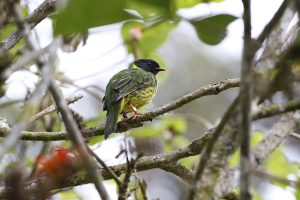Bright light bars big-eyed birds from human-altered landscapes
by Natalie van Hoose, Florida Museum of Natural History
10/1/2020

The green-and-black fruiteater, Pipreola riefferi, is a relatively small-eyed bird that lives in the canopy. This individual is one of nearly 10,000 birds banded during the project. Photo courtesy of Florida Museum; by Ian Ausprey
New research shows the glaring light in human-altered landscapes, such as livestock pastures and crop fields, can act as a barrier to big-eyed birds, potentially contributing to their decline.
Florida Museum of Natural History researchers found strong links between bird eye size, habitat and foraging technique. Birds that kept to the shade of the forest had larger eyes than those that inhabited the canopy, and birds with relatively small eyes were more numerous in agricultural settings.
The findings suggest eye size is an overlooked, but important trait in determining birds’ vulnerability to changes in their habitat and could help inform future research on their sensitivity to other bright environments, such as cities.
“Many bird species literally disappear from highly disturbed, anthropogenic habitats such as agricultural landscapes,” said lead author Ian Ausprey, a Ph.D. student in the Florida Museum’s Ordway Lab of Ecosystem Conservation and a National Geographic Explorer. “That’s probably due to many reasons, but this paper suggests light could be part of that.”
Read more here: https://www.floridamuseum.ufl.edu/science/bright-light-bars-big-eyed-birds/
Read the Ecology paper: https://esajournals.onlinelibrary.wiley.com/doi/10.1002/ecy.3213